Topic 1: Cell biology 
This page contains multiple choice questions in the style of Paper 1 of the Biology exams.
They test the breadth of your knowledge of the understandings and skills about cell biology.
To spend more time reviewing the topic before answering these questions, use the revision resources.
Cell biology revision resources
This page lists the understandings and skills expected for Topic 1 and links to the sub-topic pages which contain detailed revision notes, activities and past paper style questions. Great for revision.
Learn from any mistakes. Every question has an examiner's explanation that appears when you check your answers.
The microscope image shows cells in a tissue sample taken from a growth suspected of being cancerous.
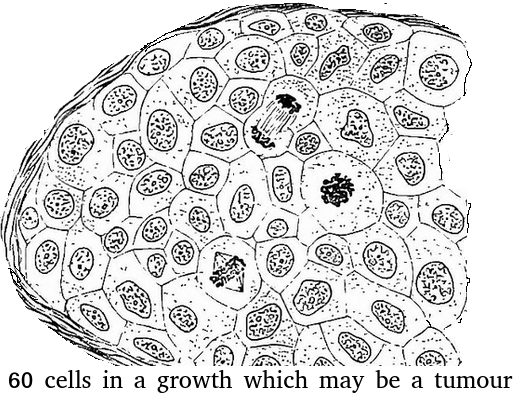
What is the best estimate of the mitotic index of this tissue?
Assume that there are exactly 60 cells (for simplicity).
Skill: Determination of a mitotic index from a micrograph
There are 3 cells in stages of mitosis.
So the mitotic index = 3 divided by 60 cells total.
Keeping it simple = 1 / 20 or 0.05
Identify the stage of mitosis for the two cells X and Y.
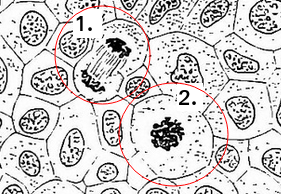
Skill: Identification of phases of mitosis in cells viewed with a microscope or in a micrograph
(prophase, metaphase, anaphase and telophase).
The graph below shows the % change in mass of carrot parenchyma slices at different concentrations of sucrose.
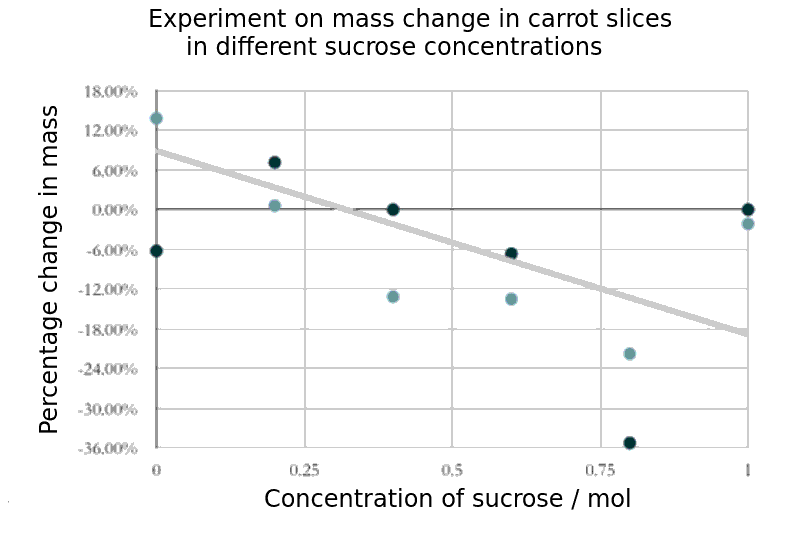
Which of the following is the best estimate of the molarity of the cytoplasm of these cells?
When a sample of cells show no change in mass, then the net movement of water by osmosis must be zero. This shows the concentration of the cytoplasm of the cells. In this graph it would be about 0.3 mol
Which property of phospholipid molecules describes the fact that they have both hydrophobic and hydrophilic parts?
Phospholipids form bilayers in water due to the amphipathic properties of phospholipid molecules. The hydrophobic tails attract each other and the hydrophilic phosphates are attracted to the water.
The electron microscope image below shows an organelle found in eukaryote cells.
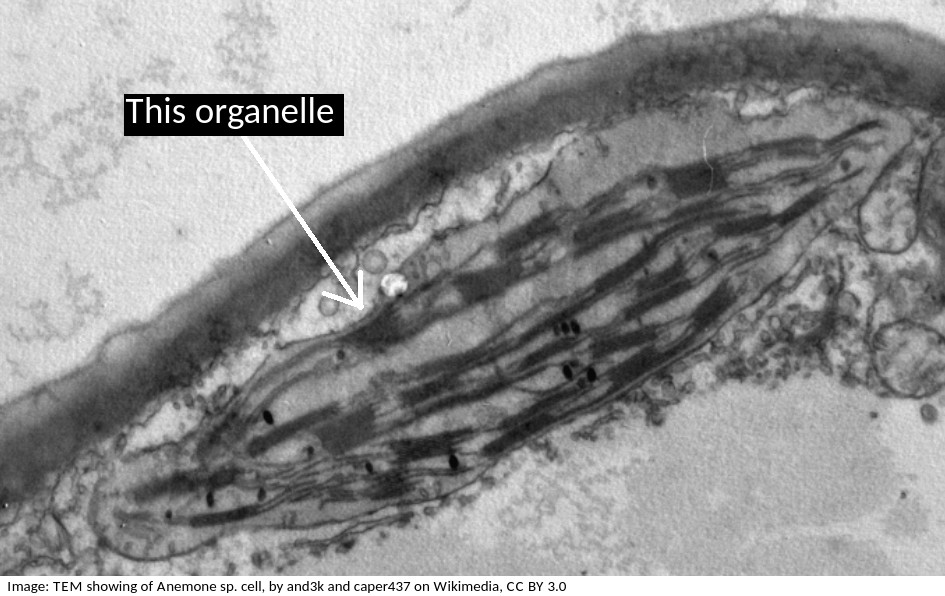
What is the name of the organelle?
Chloroplasts are distinctive because they have stacks of membranes inside, called grana, which hold the chlorophyll that absorbs light.
Cell theory covers most, but not all cases.
Which one of these statements is an exception?
Exceptions to cell theory are : multinucleated striated muscle the giant single celled Acetabularia algae?
Also, organisms consisting of only one cell carry out all functions of life in that cell. e.g. Paramecium, Chlorella.
The image below shows erythrocytes and leucocytes.l.
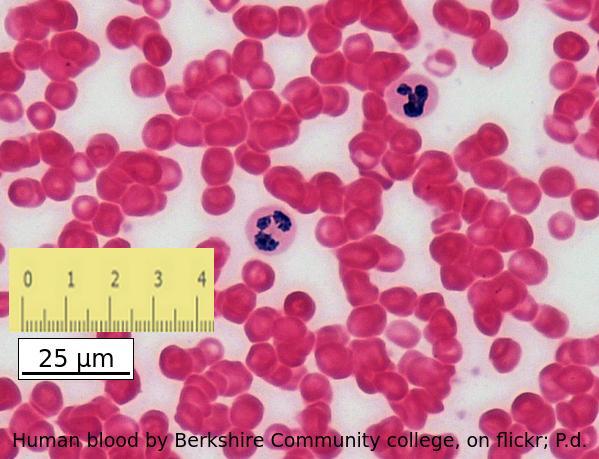
Using the scale bar and the ruler placed on the image, estimate the magnification of the image.
Which answer is the best estimate
Calculate the magnification of an electron microscope image from a scale bar?
Convert the ruler measurement to the same units written on the scale bar, in this case 25mm is 25000µm
then divide the ruler measurement 25000 by the number on the scalebar, 25.
The blood cells below were imaged using an electron microscope.
The magnification is x3000 and the ruler measures the central cell as being 2 cm in diameter.
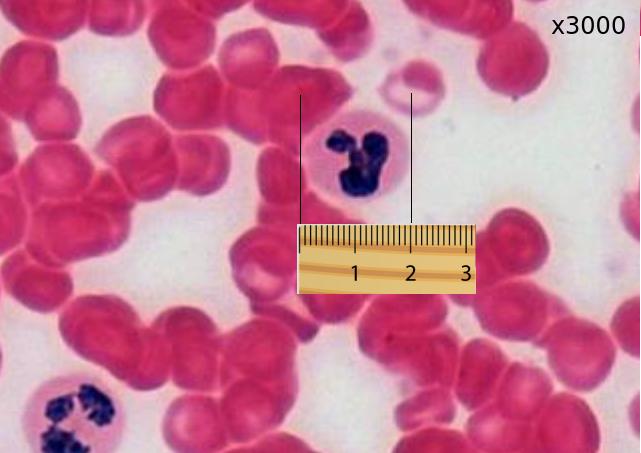
Estimate the actual size of this white blood cell.
Calculate specimen size using magnification?
First change the size measurement into µm units = 20000µm
Then divide by the magnification. 20000 / 3000 = 20 / 3 = 6.6 µm
If you know someone with a disease that might be cured by stem cell therapy then you might be a supporter of this research. You probably also know that some other people have deep concerns.
Which of the following is not a potential benefit of the use of stem cells?
There are ethical concerns about the use of embryo stem cells.
The research is expensive, and potential treatments are also likely to be expensive, and probably not available to all.
Many people who are against stem cells say that it is because cells are taken from human embryos, which have the potential for human live, and should be protected. There are other sources of stem cells, they argue.
Cells are often stored in isotonic conditions because they can be damaged in other concentrations, hypertonic, or hypotonic. Which of the descriptions of hypertonic is the most accurate?
Hypertonic solutions have a higher concentration of solutes, and lower water potentials than cells.
Which is the correct order of SI units, beginning with the largest?
Comment: SI units always have a differential of 1000. The unit without the prefix is the standard SI unit (metre, m). B and D are clearly wrong, eliminate those answers first.
The diameter of this field of view under a microscope at X400 magnification is 250 μm.
The image below shows Dracaena leaf upper epidermis cells.
Which is the best estimate of the width (from left to right) of an epidermal cell?
Comment: There are approximately 8 cells across a diameter so 250/8 = 33 μm.
Beware of the units, mm are 1000 times bigger than µm.
Which of the following are methods by which molecules can move across membranes?
I. Simple diffusion
II. Facilitated diffusion
III. Cytokinesis
IV. Active transport
There are actually four types of membrane transport which are required in DP Biology, Simple diffusion, facilitated diffusion, osmosis and active transport.
Why is a fungal hypha an exception to the cell theory?

A fungal hypha has many nuclei in a hypha but no cross walls to divide the hypha into cells.
Which organelles are found in large numbers in secretory cells in animals? I Vesicles II Golgi Body III Mitochondria IV Rough endoplasmic reticulum.

Secretory cells synthesise proteins for exocytosis so have large numbers of mitochondria to supply energy, RER to synthesise the proteins for packaging into vesicles by the Golgi Body.
The diagram is of a plasma membrane. Which label corresponds to the hydrophilic area of an amphipathic molecule?

Protein (5) has both hydrophilic and hydrophobic areas to act as an integral protein. The central channel is hydrophilic.
The microphotograph is of stratified epithelium. Cells are produced by mitosis in the area marked 1 and eventually reach the surface to replace lost cells. Which biological processes does this represent?

The cells produced by mitosis differentiate into mature cells and replace the cells lost at the surface.
Which means of transport across a plasma membrane requires the molecule shown in the picture?

A mitotic index taken from this microphotograph only would not be regarded as valid. How can a valid count be made?

The image below was taken in 1825 and shows part of the cell cycle.
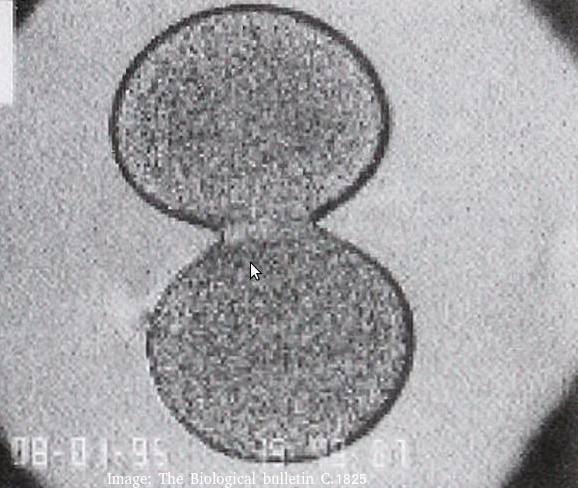
What is shown in the image?
Cytokinesis occurs after mitosis in plant and animal cells.
Animal cells form a cleavage furrow (looks like a wasps waist) as they don't have cell walls.
The two daughter cells are the same size, so cytokinesis is equal.
Refresh this page to try a new set of 20 multiple choice questions. The questions will be different next time you visit. Great revision.

 Twitter
Twitter  Facebook
Facebook  LinkedIn
LinkedIn